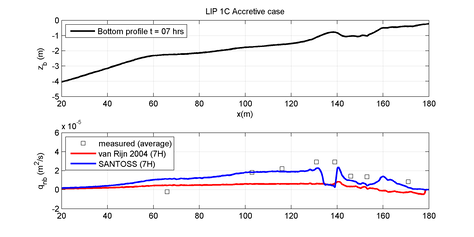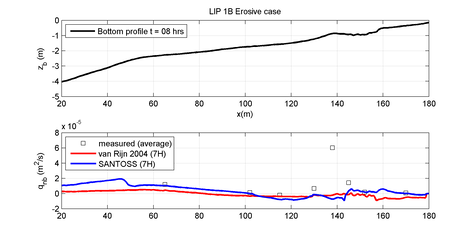Roelof Veen Graduation Date: 14 February 2014 Graduation committee: University of Twente dr. ir. J. S. Ribberink J. van der Zanden MSc. Deltares dr. ir. J. J. van der Werf | The implementation and testing of the SANTOSS sand transport model in Delft3D Morphological modelling systems like Delft3D are used to understand coastal morphodynamic and predict erosion and sedimentation. These models are important tools for coastal managers, for example for harbor design and nourishments. This study aims to assess and improve the way Delft3D models wave-driven cross-shore sand transport by implementing and testing the recently developed SANTOSS (Van der A et al., 2013) near bed transport model. The Delft3D assessment was done by modelling an erosive and accretive case of the LIP experiments (Roelvink and Reniers, 1995). The results of the near bed transport modeled with the new SANTOSS model are promising for the accretive case as the new model preforms better then the current state-of-the-art Van Rijn (2007) transport model (figure 1). For the erosive case, the SANTOSS model preforms better than Van Rijn (2007) offshore but worse onshore of the breaker bar (figure 2).
Figure 1: Bottom profile and near bed transport for the accretive beach conditions.
Figure 2: Bottom profile and near bed transport for the erosive beach conditions. The implementation in Delft3D can be improved by a more consistent coupling between the total sand transport in the wave boundary layer predicted by the SANTOSS model and the current-related suspended transport above the wave boundary layer, using the current approach with an adjusted boundary condition of the advection-diffusion model. The SANTOSS model itself could be improved by accounting for breaking-wave effects. Roelvink, J. A. and Reniers, A. (1995). Lip 11d delta flume experiments – data report. Technical report, Delft, The Netherlands, Delft Hydraulics. Van der A, D. A., Ribberink, J. S., van der Werf, J. J., O’Donoghue, T., Buijsrogge, R. H., and Kranenburg, W. M. (2013). Practical sand transport formula for non-breaking waves and currents. Coastal Engineering, 76:26-42. Van Rijn, L. C. (2007). Unified view of sediment transport by currents and waves. Journal of Hydraulic Engineering, 133: 649-689. |


